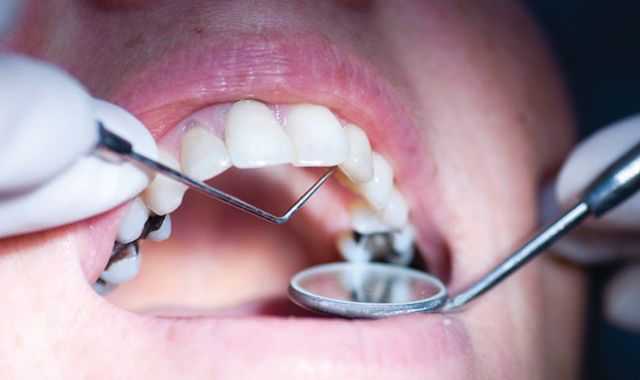Study finds protein can inhibit bone loss from periodontitis
A new study led by University of Pennsylvania School of Dental Medicine researchers demonstrates that a protein called Del-1, can inhibit bone loss associated with periodontitis.

Periodontitis, a severe form of gum disease, doesn’t just cause soft-tissue inflammation and bleeding. It also destroys the bone that supports the teeth. If it progresses unchecked, it can lead to tooth loss and is even associated with systemic inflammatory conditions like atherosclerosis and rheumatoid arthritis.
A new study led by University of Pennsylvania School of Dental Medicine researchers demonstrates that a protein called Del-1, can inhibit bone loss associated with periodontitis. They also found the protein curbs the activity of osteoclasts, cells that absorb bone tissue, leading to a mechanistic explanation of how Del-1 can prevent periodontal bone loss.
The finding paves the way for therapeutic interventions to treat periodontitis and possibly other conditions.
Trending research: Study finds link between alcohol consumption and gum health
“This is not just important for periodontitis,” said George Hajishengallis, senior author on the work and the Thomas W. Evans Centennial Professor in the Department of Microbiology at Penn Dental Medicine. “It could also have implications for other inflammatory diseases where bone loss is involved, like osteoporosis and rheumatoid arthritis.”
Previous studies by Hajishengallis and colleagues have demonstrated the important role that Del-1 plays in inhibiting the movement and accumulation of neutrophils in gum tissue in mice, and they have found a similar mechanism occurs to reduce inflammation in the central nervous system. In both scenarios, Del-1 is able to restrain the recruitment of neutrophils, which prevents damaging inflammation. The Penn scientists demonstrated that applying Del-1 to the gums can inhibit inflammation and bone loss in a mouse model of periodontitis.
But evidence from those studies also suggested that Del-1’s effect on bone loss was not solely due to its inhibition of neutrophil recruitment.
Trending research: New study shows smokers are at higher risk of losing teeth
“When we compared Del-1 with a small-molecule inhibitor of neutrophil recruitment side by side, we found that Del-1 was much more effective at inhibiting bone loss,” Hajishengallis said. “That suggested to us that Del-1 may have an additional mechanism to inhibit bone loss, perhaps by acting directly on the osteoclasts.”
Del-1 is known to be expressed on various soft tissues, such as the gums, brain and lungs, but, to confirm their suspicions that it might also be involved in bone preservation, the research team stained bone tissue for the molecule. They found evidence of Del-1 in the same areas as osteoclast activity, then followed up by generating human and mouse osteoclasts in vitro and found Del-1 mRNA and protein expressed at high levels.
Osteoclasts from mice that lacked Del-1 or from cell lines lacking the protein could be differentiated faster and stronger.
“In fact, Del-1 doesn’t block the formation of osteoclasts, but it does put the brakes on the process,” Hajishengallis said.
Further experimentation in vitro with human osteoclasts and in vivo in mice identified a portion of the Del-1 protein that was particularly important for containing osteoclast activity, though additional parts of the molecule were needed to have the most potent inhibition of inflammation and bone loss. In further mechanistic experiments using different parts of the protein, the researchers were able to dissociate the anti-inflammatory action of Del-1 from its anti-osteoclastogenic action.
“Even when we administered Del-1 after the peak recruitment of neutrophils, we were still able to significantly inhibit bone loss,” Hajishengallis said.
With this new understanding of how Del-1 can inhibit periodontal bone loss - both by reducing inflammation and by restraining the activity of osteoclasts that resorb bone tissue - the researchers tested it, in a preclinical model of periodontitis observing that Del-1 significantly reduced inflammation and tissue damage and that there was significantly less bone loss.
Trending research: Do people with tooth loss really need dentures?
Hajishengallis and colleagues have implicated Del-1 in other inflammatory diseases, including multiple sclerosis, and are beginning to examine its possible involvement in rheumatoid arthritis and osteoporosis. Unlike some drugs used to treat these diseases, Del-1 is a protein that the human body already produces, so administration of a Del-1-based drug would likely be safer than some of the alternatives, especially for local inflammatory diseases.
“I’m convinced that this is a drug that could work in humans,” Hajishengallis said.
The paper appears in the journal Science Translational Medicine.
This article is reprinted from materials provided by the University of Pennsylvania. It has been edited for content and length.
Oral Health Pavilion at HLTH 2024 Highlighted Links Between Dental and General Health
November 4th 2024At HLTH 2024, CareQuest, Colgate-Palmolive, Henry Schein, and PDS Health launched an Oral Health Pavilion to showcase how integrating oral and general health can improve patient outcomes and reduce costs.
Floss & Flip-Flops Episode 11: Diabetes Health Month
November 15th 2022Diabetes is a global disparity and most notably impacts those who are diagnosed as well as those with pre-diabetes or undiagnosed diabetes. Let’s discuss how to become better patient advocates in the screening, management and maintenance of diabetic cases.